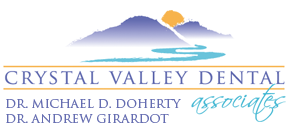Patient Forms
Cosmetic Dentistry
Almost all dentistry can be considered cosmetic assuming the treatment is visible. However, it usually applies to those areas of the mouth that are seen most immediately when you smile. There has always been an emphasis on this kind of treatment in our office, and today, with the advantages of modern materials and techniques, the high impact result is more readily attainable than ever before.
Composites:
Dental composites are made from types of synthetic resins used in dentistry as restorative material or adhesives. Nowadays, they replace the oftentimes mercury-based amalgam fillings once used to seal cavities or caries. Unlike the use of amalgam -- which essentially just fill a hole -- composite cavity technique will restore the tooth back to near its original form.
Crowns & Bridges:
A crown is a type of dental restoration that completely caps or encircles a tooth or dental implant. Crowns are often needed when a large cavity threatens the ongoing health of a tooth.
Crowns can be made from many materials from porcelain to gold, and are often used to improve the strength or appearance of teeth. Inarguably beneficial to dental health, the most common method of crowning a tooth involves using a dental impression of a prepared tooth by a dentist to fabricate the crown outside of the mouth. As new technology and materials science has evolved, computers are increasingly becoming a part of crown and bridge fabrication, such as the E4D CAD/CAM Dentistry available at Crystal Valley Dental Associates.
A bridge, also known as a fixed partial denture, is a dental restoration used to replace a missing tooth by joining permanently to adjacent teeth or dental implants.
Types of bridges may vary, depending on how they are fabricated and the way they anchor to the adjacent teeth. Bridges can be fabricated directly in the mouth using such materials as composite resin. Materials used for the bridges include gold, porcelain fused to metal, or porcelain alone.
Anterior Restoration:
Matching for anterior restorations is accomplished by seeing the patient in the lab for a custom shade photo appointment. The patient is seen by one of the technicians who is actually fabricating the restorations, photos are taken, and a consultation about their expectation of shade matching takes place.
Veneer:
In dentistry, a veneer is a thin layer of restorative material placed over a tooth surface, either to improve the aesthetics of a tooth, or to protect a damaged tooth surface. There are two main types of material used to fabricate a veneer: composite and dental porcelain. A composite veneer may be directly placed (built-up in the mouth), and a porcelain veneer may be fabricated in-office by a dental technician using, for example, E4D Dentist technology available at Crystal Valley Dental Associates.
Teeth Cleaning:
Regular teeth cleaning by a registered dental hygienist is part of good oral hygiene and involves the removal of dental plaque from teeth with the intention of preventing cavities (dental caries), gingivitis, and periodontal disease. People routinely clean their own teeth by brushing and flossing, but hygienists can remove hardened deposits not always removed by regular cleaning.
Teeth Whitening:
Teeth whitening or tooth bleaching is a common procedure in general dentistry, but most especially in the field of cosmetic dentistry. A child's deciduous or “baby” teeth are generally whiter than the adult teeth that follow. As a person ages, the adult teeth often become darker due to changes in the mineral structure of the tooth, and other factors like diet. Tooth bleaching is not a modern practice; Ancient Romans, for example, used teeth whiteners.
Periodontics:
Periodontics (peri: around, dental: tooth) is the science that studies and treats the areas of the mouth that support the teeth, namely the bone and gums. Periodontal conditions change with age and in response to the overall oral environment.
Potential periodontal diseases such as plaque, gingivitis, and periodontitis are monitored by your hygienist at regular teeth cleaning appointments.
If you would like more information about one or more of these treatment therapies, call us for a screening.

